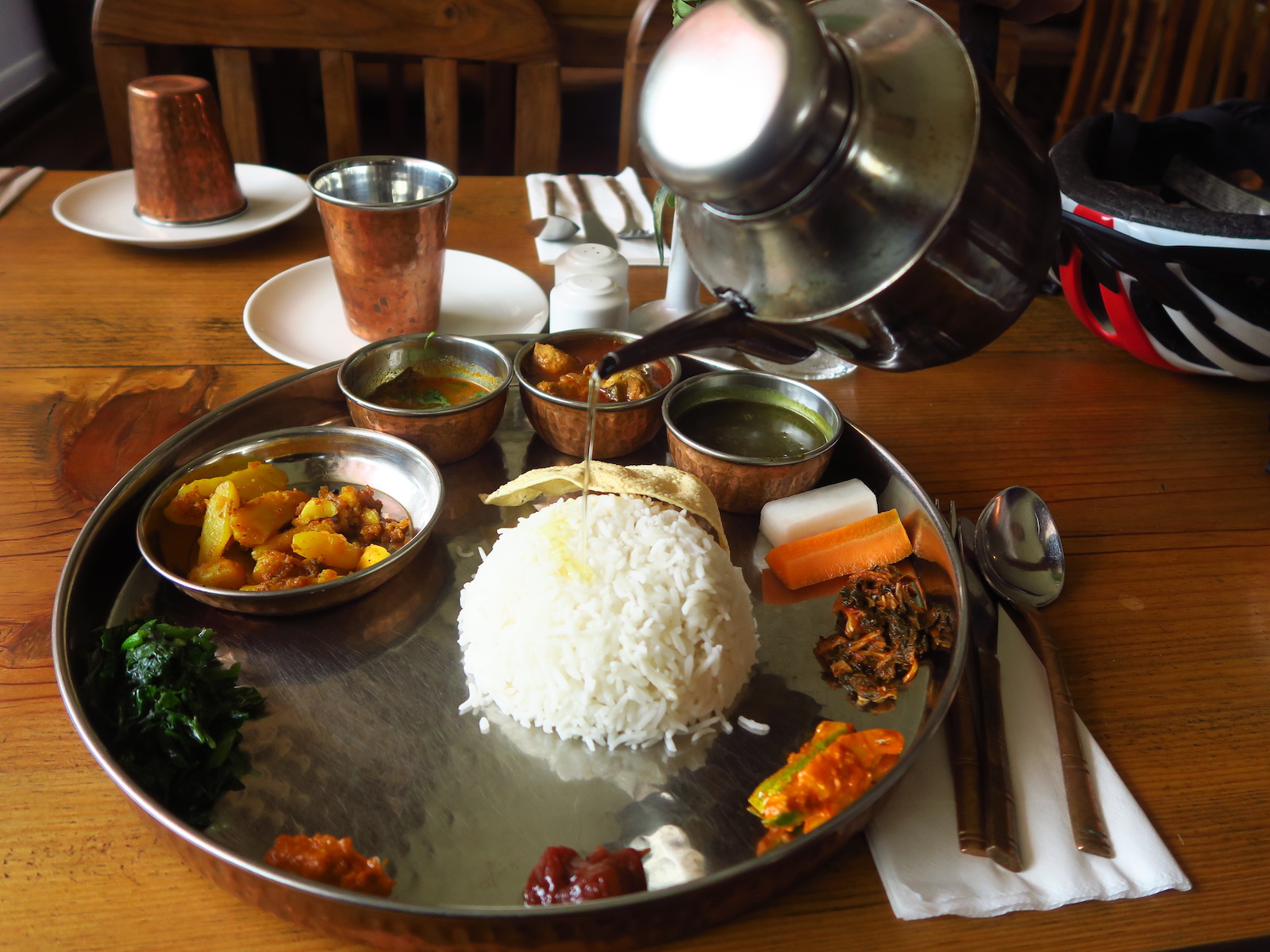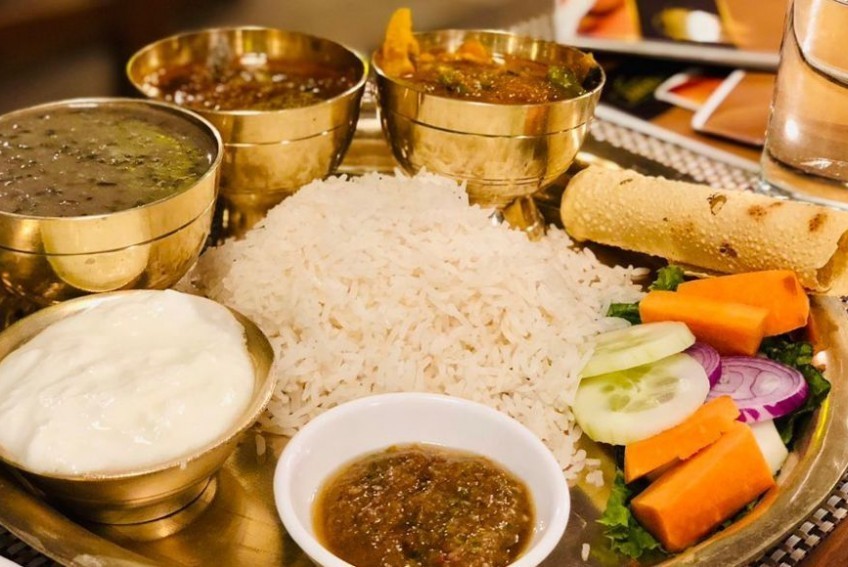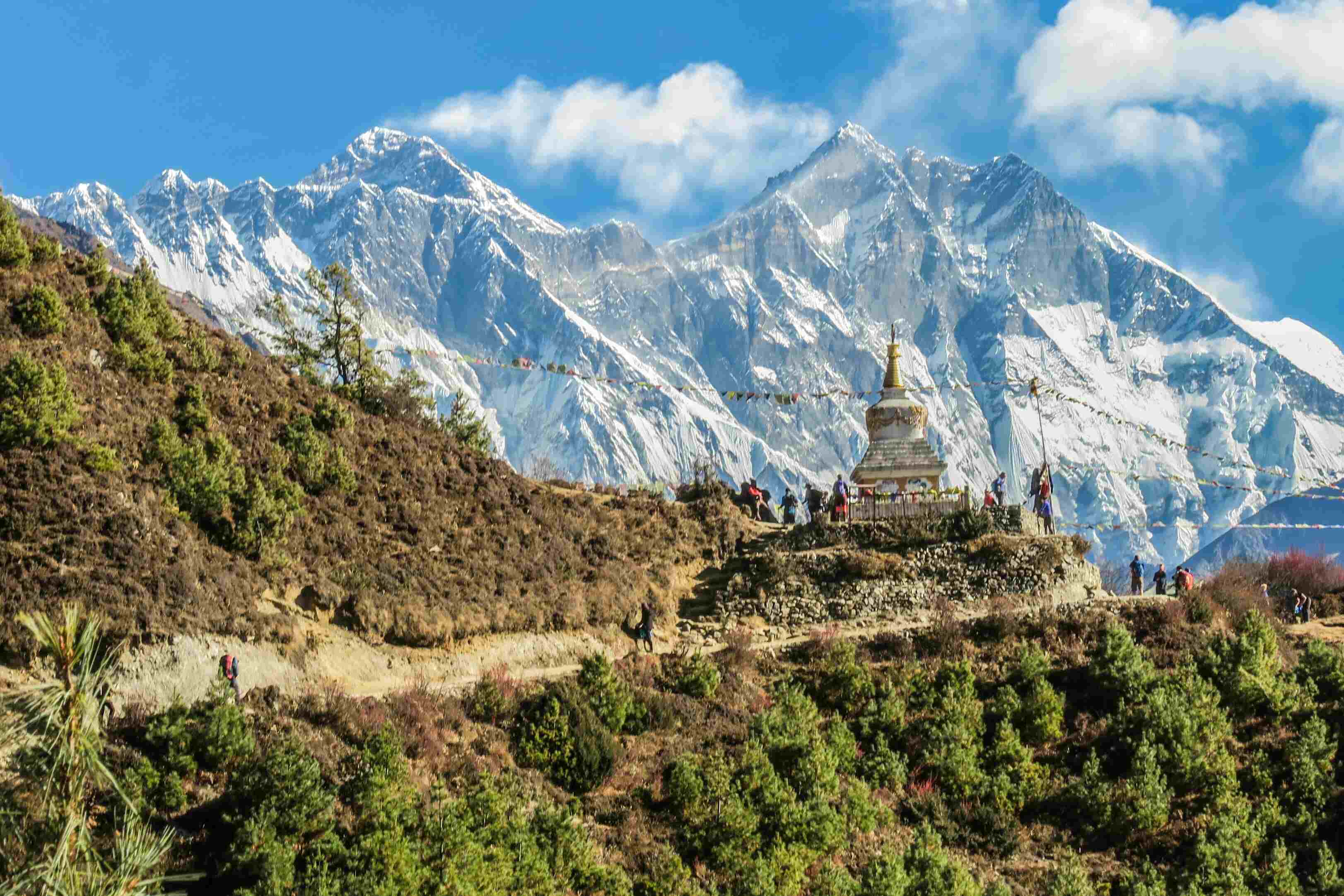Share this Article
1. Introduction: Thakali Cuisine as Nepal’s Culinary Gem
In Nepal’s culinary landscape, there are few cuisines as admired, respected, and universally enjoyed as Thakali food. Wherever one travels in the country—whether to the bustling lanes of Kathmandu, the lakeside eateries of Pokhara, or the quiet roadside inns along highways—the comforting presence of a Thakali restaurant seems inevitable. For many Nepalis, “going out for Thakali” has become almost synonymous with having a wholesome, complete meal. But Thakali cuisine is far more than just food—it is an intricate tapestry of geography, trade, history, and cultural philosophy. Its reputation for balance, cleanliness, and consistency in flavor has elevated it into a national culinary identity, while still holding on to its deeply rooted Himalayan heritage.
The story of Thakali cuisine is also the story of resilience and adaptation. From the cold, arid valleys of Mustang where resources were scarce, the Thakali people crafted a cuisine that could withstand harsh climates while still celebrating taste. Over time, this practical yet deeply flavorful food system moved from Himalayan inns to city restaurants, carving a permanent place in the Nepali heart and palate.
2. Roots of Thakali Cuisine in Mustang
Thakali cuisine originates from Mustang, a region that lies in the rain shadow of the Annapurna and Dhaulagiri ranges. This landscape is stark and dramatic, defined by arid valleys, high-altitude winds, and limited agricultural potential. Unlike the fertile Terai or the mid-hills, Mustang did not allow its people the luxury of abundant rice or tropical vegetables. Instead, the Thakali people relied on hardy grains like barley, buckwheat, and millet, which could grow in tough conditions. This reliance shaped not only their diet but also their resourcefulness.
Historically, the Thakali people were also traders. Mustang lay along the salt and wool trade routes that connected Tibet with the southern valleys of Nepal and India. Thakali families ran inns, known as bhattis, which became resting points for traders, pilgrims, and travelers. These inns were more than stopovers; they were cultural melting pots where Tibetan, Nepali, and Indian influences mingled. The food served here—simple but hearty, spiced but not overwhelming, always warm and nourishing—became legendary. This tradition of feeding travelers with honesty and hospitality planted the seeds of what would later evolve into the thriving Thakali restaurant culture across Nepal.
3. The Thakali Kitchen: Philosophy of Flavor
At the heart of Thakali cuisine lies a philosophy that values balance. A true Thakali meal never overwhelms with one flavor. Instead, it orchestrates a symphony of taste—mildly spicy, slightly tangy, richly earthy, and subtly aromatic. The use of spices is deliberate and restrained. Unlike Indian cuisine, where heavy masalas dominate, Thakali cooking often allows ingredients to shine on their own.
Certain spices, however, are characteristic of Thakali kitchens. Jimbu, a dried Himalayan herb, is used to temper lentils and soups, adding a smoky, onion-like depth. Timur, a type of Sichuan pepper native to the region, provides a unique numbing spice often found in pickles and chutneys. Garlic, ginger, and fenugreek are used with discipline, often toasted lightly to release aroma without overwhelming the dish. The goal is not intensity, but harmony. This subtlety reflects the Thakali worldview: food as nourishment, not excess; flavor as balance, not indulgence.
4. Staple Ingredients and Food Practices
The backbone of Thakali cuisine is the dal-bhat set, but it differs from the generic Nepali plate in its discipline and refinement. Rice is common today, but in Mustang, people originally relied on barley, millet, and buckwheat. These grains were turned into porridge, pancakes, or steamed dumplings. With trade and migration, rice was adopted, but the older grains remain cherished in traditional households.
Lentils form the protein base of most meals. Carefully tempered with jimbu and garlic, Thakali dal is thinner and more aromatic than its southern counterparts. Vegetables are equally important—seasonal greens like spinach, mustard leaves, or radish tops are stir-fried or made into soups. In high altitudes, wild greens and preserved vegetables were once essential survival foods.
Meat holds a special role, especially in festivals or communal meals. Yak, mutton, and chicken were traditional, while pork and beef were less common. Meat dishes are often slow-cooked, spiced modestly, and enjoyed with rice or buckwheat bread. What makes the Thakali table distinctive is the emphasis on side accompaniments—pickles, soups, greens, and chutneys—that transform a simple plate of rice and dal into a wholesome feast.
5. Seasonal Eating in Thakali Tradition
One of the most remarkable aspects of Thakali food culture is its attention to seasonality. In the high Himalayas, food was never just about taste—it was about survival. In winter, when snow blanketed Mustang, families relied on warming foods like yak meat stews, buckwheat pancakes with butter, and fermented vegetables. These calorie-dense meals kept energy levels high and bodies warm.
Summer brought lighter preparations. Fresh greens, lentil soups, and foraged herbs refreshed the body. The philosophy of eating in tune with the environment ensured health and sustainability. Preservation was also key: gundruk (fermented leafy greens) and sukuti (dried meat) allowed families to stretch resources into lean months. Today, even in urban Thakali restaurants, these traditions persist. Customers savor seasonal dishes, not just for nostalgia, but because they embody a sustainable, mindful way of eating.
6. The Iconic Thakali Thali
Central to Thakali cuisine is the Thakali thali, a complete meal that exemplifies balance and variety. Unlike a generic dal-bhat plate, the Thakali thali is carefully curated to provide a harmony of flavors, textures, and nutrients. Typically, it includes a serving of rice or dhido (a thick buckwheat or millet porridge), lentil soup, a variety of vegetable dishes, pickles, greens, and a portion of meat such as goat or chicken. The thali often features ghee or clarified butter poured over the rice, which enhances aroma and richness, while small side dishes like papad or seasonal chutneys complete the ensemble.
The Thakali thali is not only about nourishment but also aesthetics and hospitality. Each component is placed thoughtfully on the plate, emphasizing balance and neatness. This practice originates from the hospitality traditions of Thakali inns, where presentation was a sign of respect for guests. Even in modern restaurants, the thali is served with precision, demonstrating the cultural value the Thakali people place on cleanliness, order, and the joy of shared meals.
7. Thakali Pickles (Achaar) and Side Dishes
A defining feature of Thakali cuisine is its variety of pickles and side dishes, which elevate even the simplest meal. Gundruk ko achar, made from fermented leafy greens, provides earthy, tangy notes. Lapsi achar, a tangy pickle from local Himalayan fruit, adds a citrusy punch, while tomato-timur achar brings spice and fragrance. These pickles are far more than accompaniments; they are essential elements that transform a meal, offering contrast to rice, lentils, and meat.
Side dishes like sautéed seasonal greens, stir-fried potatoes, or lightly spiced beans complement the main components. The combination of soft, crunchy, tangy, and spicy items ensures that each bite is dynamic and satisfying. In many ways, the pickles and sides carry the identity of Thakali cuisine, reflecting local ingredients, seasonality, and the community’s culinary ingenuity.
8. Dining Etiquette and Cultural Practices
In Thakali culture, how food is served and eaten is as important as the ingredients themselves. Meals are served with care, emphasizing order and respect for the guest. Traditionally, the eldest member of the household or guest is served first. Family members or visitors share from the same thali or plates, reinforcing community bonds. Cleanliness is paramount, from polished brass plates to tidy serving areas.
Women have historically played a central role in maintaining these practices. They are custodians of recipes, overseers of preparation, and often manage inn kitchens. This cultural discipline ensures that every Thakali meal, whether in a humble home or an upscale restaurant, embodies not only taste but also the values of hospitality, respect, and harmony.
9. From Inns to Urban Restaurants
The journey of Thakali cuisine from Himalayan inns to city restaurants is a story of migration, adaptation, and entrepreneurship. Historically, Thakali families managed bhattis along trade routes, gaining a reputation for clean, reliable meals. With the decline of traditional trade, many migrated to cities like Pokhara and Kathmandu, establishing restaurants that retained the flavors and hospitality of their mountain homes.
By the late 20th century, Thakali restaurants had become staples in urban Nepal. Their success was not just due to taste but also trustworthiness, hygiene, and consistency. Students, office workers, and travelers alike relied on Thakali eateries for reliable meals. Today, they are ubiquitous across cities, ranging from small local kitchens to high-end restaurants offering refined thali sets and fusion dishes.
10. Thakali Women and Entrepreneurship
Women have been pivotal in both preserving and spreading Thakali cuisine. They oversee recipe preparation, manage kitchens, and often serve as the face of family-run restaurants. In many households, knowledge of cooking is passed from mother to daughter, ensuring that traditional flavors and methods endure.
Beyond preservation, women have also been central to entrepreneurship. In cities, many Thakali-owned restaurants are led by women managers or chefs who innovate while keeping tradition intact. Their contribution ensures that the cuisine remains dynamic, adaptive, and accessible to diverse customers, both locally and internationally.
11. Regional Variations of Thakali Cuisine
Though Thakali cuisine maintains a recognizable core, subtle regional variations exist. In Mustang, the traditional Himalayan version emphasizes buckwheat, barley, and yak meat, with heavier reliance on gundruk and fermented foods due to seasonal scarcity. In Pokhara, fresh vegetables and chicken are more prominent, reflecting local availability. Kathmandu restaurants adapt further for urban preferences, often offering vegetarian options, lighter oil usage, and even fusion adaptations.
Internationally, Nepali diaspora restaurants may incorporate locally available ingredients while preserving essential spices and preparation methods. Despite these variations, the underlying principle—balance, hospitality, and nourishment—remains unchanged.
12. Fusion and Modern Thakali Food
Modern Thakali cuisine has begun blending tradition with innovation. Chefs experiment with buckwheat noodles, millet pancakes, or Thakali-inspired momo, appealing to younger, health-conscious diners. Fine-dining restaurants present thali sets with artistic plating, small portions, and fusion condiments while preserving authentic spices. Urban experimentation ensures that Thakali cuisine evolves without losing its cultural soul.
This adaptability also strengthens its appeal globally. Thakali food has become a bridge between tradition and modern gastronomy, satisfying both nostalgic Nepalis and adventurous food lovers abroad.
13. Tourism and Thakali Cuisine
Thakali cuisine plays a vital role in Nepal’s tourism, particularly for trekkers and adventure travelers. Along the Annapurna Circuit and Mustang trekking routes, Thakali inns and kitchens are a key part of the trekking experience. After long days of walking, hikers find the warm, hearty, and balanced Thakali thali not just satisfying but restorative. The dal, rice, seasonal vegetables, and pickles provide essential nutrients and energy for high-altitude trekking.
Beyond nourishment, Thakali food offers cultural immersion. Tourists gain a glimpse of Himalayan lifestyle, hospitality, and culinary traditions in every meal. Restaurants in Pokhara and Kathmandu also cater to international visitors, often explaining the ingredients, methods, and historical context of dishes. In this way, Thakali cuisine has become both a culinary and cultural ambassador for Nepal, introducing global travelers to authentic Himalayan flavors.
14. Health and Nutrition in Thakali Food
Thakali cuisine is inherently nutritional and well-balanced, reflecting centuries of adaptation to harsh Himalayan environments. Lentils and pulses form a protein-rich foundation, providing essential amino acids, fiber, and energy. Buckwheat, barley, and millet, often used in dhido or pancakes, are nutrient-dense and naturally gluten-free. Seasonal vegetables, fermented greens like gundruk, and pickles contribute vitamins, minerals, and probiotics, supporting digestive health.
Meat dishes, when included, are lean and slow-cooked, preserving nutrients without excessive oil. The careful balance of spices not only enhances flavor but also aids digestion and boosts metabolism. In essence, Thakali cuisine embodies traditional Himalayan wellness, where taste, sustenance, and health coexist naturally in every meal.
15. Thakali Food and Cultural Identity
For the Thakali people, food is deeply tied to identity and heritage. Traditional dishes are integral to festivals, rituals, and family gatherings, serving as markers of cultural continuity. Even as Thakalis migrate to cities or abroad, the cuisine remains a key link to home.
In urban restaurants, Thakali food becomes a symbol of reliability, authenticity, and pride. It not only preserves heritage but also educates outsiders about the community’s values of hospitality, discipline, and respect. The cuisine’s ability to retain its essence while adapting to modern tastes ensures that it continues to be a cornerstone of Thakali cultural identity, uniting generations and communities.
16. Sustainability and Food Practices
Sustainability has long been part of Thakali food culture, shaped by the environmental realities of the Himalayas. Locally sourced grains, seasonal vegetables, and preserved foods minimize dependency on distant resources. Fermentation and drying techniques allow ingredients to last through harsh winters, reducing waste.
Modern Thakali restaurants often continue this philosophy, sourcing ingredients from local farmers, using minimal packaging, and following eco-friendly cooking practices. The cuisine exemplifies a model of sustainable eating, blending traditional wisdom with contemporary environmental awareness.
17. Economics of Thakali Restaurants
Thakali restaurants are not only cultural landmarks but also successful business ventures. The community’s reputation for clean, organized, and consistent service created trust that became a brand in itself. Families who migrated to urban centers leveraged this reputation, offering a combination of quality food, reliable hygiene, and welcoming hospitality.
Economically, Thakali kitchens have become a stable source of income, providing livelihoods for generations. Their adaptability—introducing vegetarian options, fusion dishes, and catering to tourists—ensures resilience in a competitive food industry. This balance of tradition and entrepreneurship makes Thakali restaurants a model of cultural and economic sustainability.
18. The Future of Thakali Cuisine
The future of Thakali cuisine looks both promising and challenging. Globalization and digital platforms allow Thakali food to reach international audiences through food blogs, delivery apps, and social media. Chefs experiment with fusion concepts while maintaining traditional techniques, offering new interpretations of dal-bhat, thali sets, and pickles.
At the same time, preserving authenticity is critical. Younger generations may be tempted to simplify recipes or use shortcuts, risking dilution of the original flavors. However, culinary festivals, cookbooks, and cultural programs help document recipes and promote awareness. The future of Thakali cuisine lies in innovation balanced with respect for tradition, ensuring that the taste of the Himalayas endures for decades to come.
19. Conclusion: The Everlasting Taste of the Himalayas
Thakali cuisine is a remarkable example of how food transcends geography, culture, and time. From the rugged valleys of Mustang to city restaurants in Kathmandu, Pokhara, and beyond, it embodies resilience, hospitality, and adaptability. Each Thakali thali tells a story—of mountains, trade, family, and tradition.
Its journey from Himalayan inns to urban eateries reflects the evolution of a community that values balance, respect, and nourishment. With its nutritious ingredients, thoughtful spice combinations, and culturally rich presentation, Thakali food continues to captivate both locals and international visitors. More than a meal, it is a celebration of heritage, a bridge between mountains and cities, and a living symbol of Nepal’s diverse culinary landscape.
As long as the Thakali people continue to cook with care, teach the next generation, and share their food with the world, the everlasting taste of the Himalayas will remain alive, hearty, and unforgettable.
Categories:
Food & Drink
Tags:
ThakaliCuisine
,
HimalayanFood








